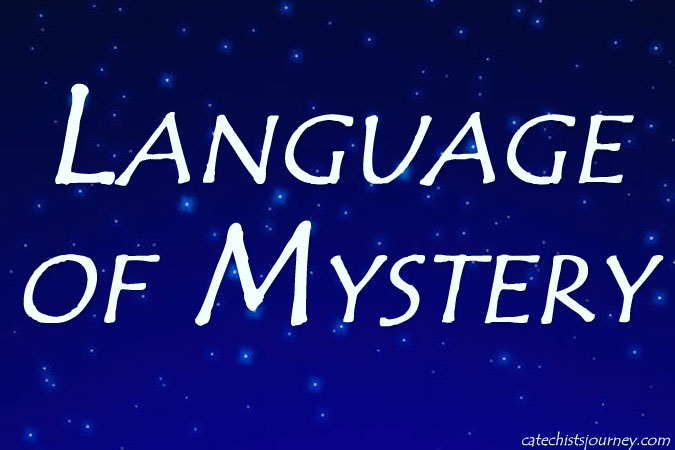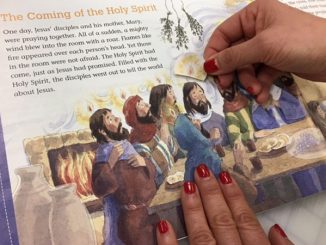
When my mom was 13 years old and unbaptized, she hung around with her best friend Ramona who, like the rest of her family, was a practicing Catholic. Once, when my mom went with Ramona’s family to Sunday Mass, she observed them all go up to receive Communion and come back to their places to kneel in prayer with a look of joyful contentment on their faces. After Mass, my mom asked Ramona’s mother, “What do you go up there to get from the priest?” Without hesitation, Ramona’s mother broke into a big smile and said, “The greatest gift you could ever imagine!”
Within a year, my mom was baptized and received her First Holy Communion!
Ramona’s mom did not respond to my mom doctrinally. She didn’t talk about transubstantiation or consecration. Rather, she ignited my mom’s imagination by inviting her to enter into a mystery. When it comes to sacramental preparation for children, we too often think that, in order for them to be truly disposed to receive the sacraments, they need to have the Catechism of the Catholic Church memorized. While it is important for young people to know their faith and be able to articulate it, that should only come after they have been led into an experience of encountering God’s mysterious presence. We need to tap into their innate sense of wonder and awe and “entice” them—as my mom was “enticed” into receiving the Eucharist—into the world of mystery.
How do we do this? By using a language of mystery—a language that transcends words. When it comes to preparing children for the sacraments, especially First Eucharist, we need to invite them to expand their “vocabulary” beyond words by using the language of mystery the Church provides for us. Consider the following:
- Song—Singing lifts our hearts in ways that speaking simply cannot. That’s why we have Broadway musicals! Incorporating music and singing (or at least listening to sacred hymns) can touch hearts in a way that the spoken word cannot.
- Ritual—We rely on rituals to take us out of the ordinary and into the extraordinary. Catechists can integrate numerous rituals into their lessons: ritually setting up a prayer table, beginning class with a ritual greeting (e.g. “Our help is from the Lord.” R: “Who made heaven and earth.”), ending class by having kids sign themselves with holy water, etc.
- Sign and Symbol—Signs and symbols speak to us at another level. An American flag flapping in the wind to the sound of “America the Beautiful” can make one misty-eyed. As a sacramental Church, we rely on signs and symbols. Catechists can set up a prayer table with sacred signs and symbols (cross, holy water, Bible, cloth in the color of the liturgical season, and icons) and invite children to bring symbols of their own to add to it.
- Silence and Reverence—On a trip to Pearl Harbor, I was struck by the silence and reverence throughout the site. We can sanctify our learning environment by incorporating periods of silence, thus teaching the virtue of reverence. Leading guided reflections and ending them with a few minutes of complete silence can bring about a profound sense of the sacred.
- Gesture and Movement—God asked Moses to remove his sandals, for he was standing on sacred ground. We perform gestures and movements to express the sacred. Catechists can incorporate processions into their classes to enthrone the Bible and set up the prayer table. Likewise, children can be invited to make the threefold Sign of the Cross on their forehead, lips, and chest as a way of asking that God’s Word be in their minds, on their lips, and in their hearts as the lesson progresses.
- Metaphor—We can know God, but we can never completely know God, for God is mystery. Thus, we use metaphors to assist us in our understanding of God: Our Shepherd; Our Light; Jesus is the Bread of Life; etc. We can invite students to encounter God in metaphors by inviting them to create crafts that symbolize an aspect of God.
- Storytelling—Ultimately, we catechists are storytellers. We are telling the story of our Salvation and inviting others to enter into that story and to allow that story to guide their lives. We need to remember that we are not teaching a science but telling a profound and extraordinary story. Students can enter into the story by role-playing Scripture stories. Catechists can explore and integrate creative ways of dramatically telling the stories of Salvation history.
Some approaches to sacramental preparation seem designed to create little “masters of divinity” with an over-emphasis on children parroting doctrinal formulas. Some more recent approaches seem to think that the way to a child’s heart is through showing cartoons. I prefer to reach hearts and minds in the way that God does—through a language of mystery. This approach is embodied masterfully in the God’s Gift: Reconciliation and Eucharist program from Loyola Press.
How do you incorporate a language of mystery in your sacramental preparation?




As catechist, lector and choir ministry, I appreciate your parent’s experience and your theological presentation.
Thanks Patricia!
AWESOME! I was just preparing my parent formation lesson and this is the topic! I couldn’t have said this in a better way, we must have our children encounter Jesus, not just have prayers memorized! Now, all I have to do is share this with my catechists!
Hi Rosalie! Happy for the perfect timing!
Thank you! What a valid approach. So important to entice and allow the children to be drawn to the love of faith. As a Good Shepherd catechist we are trained in this way and feel we already cover all your pointers, and is the reason I love being a catechist. Our sacrament of FHC will be taking place on the 3rd of June, please keep our children in your prayers.
Thank you Caroline! Catechesis of the Good Shepherd has always done a wonderful job of creating a sense of reverence and mystery! Congrats to you and your First Communicants!